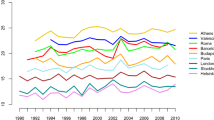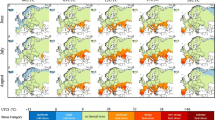Abstract
Global environmental change, in particular climate change, will have adverse effects on public health. The increased frequency/intensity of heat waves is expected to increase heat-related mortality and illness. To quantify the climatic risks of heat-related mortality in Lisbon an empirical-statistical model was developed in Part I, based on the climate-mortality relationship of the summer months of 1980–1998. In Part II, scenarios of climate and population change are applied to the model to assess the potential impacts on public health in the 2020s and 2050s, in terms of crude heat-related mortality rates. Two regional climate models (RCMs) were used and different assumptions about seasonality, acclimatisation and the estimation of excess deaths were made in order to represent uncertainty explicitly. An exploratory Bayesian analysis was used to investigate the sensitivity of the result to input assumptions. Annual heat-related death rates are estimated to increase from between 5.4 and 6 (per 100,000) for 1980–1998 to between 5.8 and 15.1 for the 2020s. By the 2050s, the potential increase ranges from 7.3 to 35.6. The burden of deaths is decreased if acclimatisation is factored in. Through a Bayesian analysis it is shown that, for the tested variables, future heat-related mortality is most sensitive to the choice of RCM and least to the method of calculating the excess deaths.




Similar content being viewed by others
References
Carter TR, LaRovere EL, Jones RN, Leemans R, Mearns LO, Nakicenovic N, Pittock AB, Semenov SM, Skea J (2001) Developing and applying scenarios. In: McCarthy JJ, Canziani OF, Leary NA, Dokken DJ, White KS (eds) Climate change 2001: Impacts, adaptation, and vulnerability. Cambridge University Press, Cambridge, pp 145–190
Castro M, Fernandez C, Gaertner MA (1993) Description of a mesoscale atmospheric numerical model. In: Diaz JI, Lions JL (eds) Mathematics, climate and environment. Recherches en mathematics appliques. Series Mason, pp 227–251
Dessai S (2002) Heat stress and mortality in Lisbon. Part I. Model construction and validation. Int J Biometeorol 47:6–12
Doherty R, Hulme M, Lu X (2000) Interim UKCIP98 daily weather scenarios. http://www.cru.uea.ac.uk/∼mikeh/datasets/uk/maff75869/maff2000_data.htm
Donaldson G, Kovats RS, Keatinge WR, McMichael AJ (2002) Heat- and cold-related mortality and morbidity and climate change. In: Health effects of climate change in the UK. Department of Health, London pp 70–80
Duncan K, Guidotti T, Cheng W, Naidoo K, Gibson G, Kalkstein L, Sheridan S, Waltner-Toews D, MacEachern S, Last J (1997) Health sector. In: Canada Country Study: impacts and adaptation. Environment Canada, pp 520–580
Gallardo C, Arribas A, Prego JA, Gaertner MA, Castro M (2001) Multi-year simulations using a regional-climate model over the Iberian Peninsula: current climate and doubled CO2 scenario. Q J R Meteorol Soc 127:1659–1681
Guest CS, Willson K, Woodward A, Hennessy K, Kalkstein LS, Skinner C, McMichael AJ (1999) Climate and mortality in Australia: retrospective study, 1979–1990 and predicted impacts in five major cities. Clim Res 13:1–15
Hulme M, JenkinsGJ, Lu X, Turnpenny JR, Mitchell TD, Jones RG, Lowe J, Murphy JM, Hassell D, Boorman P, McDonald R, Hill S (2002) Climate change scenarios for the United Kingdom. The UKCIP02 scientific report. Tyndall Centre for Climate Change Research, School of Environmental Sciences, University of East Anglia, Norwich, UK
Johns TC, Carnell RE, Crossley JF, Gregory JM, Mitchell JFB, Senior CA, Tett SFB, Wood RA (1997) The second Hadley Centre coupled ocean–atmosphere GCM: model description, spinup and validation. Clim Dyn 13:103–134
Jones RG, Murphy JM, Noguer M, Keen AB (1997) Simulation of climate change over Europe using a nested regional climate mode II. Comparison of driving and regional model responses to a doubling of carbon dioxide. Q J R Meteorol Soc 123:265–292
Jones RN, Page CM (2001) Assessing the risk of climate change on the water resources of the Macquire catchment. In: Ghassemi F, Whetton P, Little R, Littleboy M (eds) Integrating models for natural resources management across disciplines, issues and scales. Modelling and Simulation Society of Australia and New Zealand, Canberra, pp 673–678
Kalkstein LS, Greene JS (1997) An evaluation of climate/mortality relationships in large U.S. cities and the possible impacts of a climate change. Environ Health Perspect 105:84–93
Kilbourne EM (1997) Heat waves and hot environments. In: Noji EJ (ed) The public health consequences of disasters. Oxford University Press, Oxford, pp 245–269
Kim J, Kim T-K, Arritt RW, Miller NL (2002) Impacts of increased atmospheric CO2 on the hydroclimate of the Western United States. J Clim 15:1926–1942
Kovats RS (1999) Climatic variability: daily temperature extreme. Commentary presented at Workshop 1. Health and climate variability in Masstricht, The Netherlands 24–26 September 1999. http://geog.queensu.ca/h_and_e/healthandenvir/workshop1.htm
McMichael AJ, Haines A, Slooff R, Kovats RS (eds) (1996) Climate change and human health: an assessment by a task group on behalf of the World Health Organization, the World Meteorological Organization and the United Nations Environment Programme, WHO, Geneva
McMichael AJ, Akhtar R, Carcavallo R, Gubler D, Haines A, Kovats RS, Martens P, Patz J, Sasaki A (2001) Human health. In: McCarthy JJ, Canziani OF, Leary NA, Dokken DJ, White KS (eds) Climate change 2001. Impacts, adaptation, and vulnerability. Cambridge University Press, Cambridge, pp 451–485
Mearns LO, Easterling W, Hays C, Marx D (2001a) Comparison of agricultural impacts of climate change calculated from high and low resolution climate change scenarios. Part I. The uncertainty due to spatial scale. Clim Change 51:131–172
Mearns LO, Hulme M, Carter TR, Leemans R, Lal M, Whetton P (2001b) Climate scenario development. In: Houghton JT, Ding Y, Griggs DJ, Noguer M, Linde PJ van der, Dai X, Maskell K, Johnson CA (eds) Climate change 2001: the scientific basis. Cambridge University Press, Cambridge, pp 734–768
Miranda P, Coelho FES, Tomé AR, Valente MA (2002) 20th century Portuguese climate and climate scenarios. In: Santos FD, Forbes K, Moita R (eds) Climate change in Portugal: scenarios, impacts and adaptation measures. Gradiva, Lisboa, pp 23–83
Moss R (2003) Developing socioeconomic scenarios for use in vulnerability and adaptation assessments. National Communications Support Programme. Global Environment Facility (in press)
Moss R, Schneider S (2000) Uncertainties. In: Pachauri R, Taniguchi T, Tanaka K (eds) Guidance papers on the cross cutting issues of the third assessment report of the IPCC. IPCC, Geneva, pp 33–51
Nakićenović N, Swart R (eds) (2000) Special report on emission scenarios. Cambridge University Press, Cambridge
New M, Hulme M (2000) Representing uncertainty in climate change scenarios: a Monte-Carlo approach. Integrated Assessment 1:203–214
Nogueira PJ, Nunes B, Dias CM, Falcão JM (1999) Um sistema de vigilância e alerta de ondas de calor com efeitos na mortalidade: o índice Ícaro. Rev Port Saúde Púb 1:67–77
Noguer M, Jones R, Murphy J (1998) Sources of systematic errors in the climatology of a regional climate model over Europe. Clim Dyn 14:691–712
PRUDENCE (2002) Prediction of regional scenarios and uncertainties for defining European climate change risks and effects. http://www.dmi.dk/f+u/klima/prudence/
Sarewitz D, Pielke RA Jr (2000) Prediction in science and policy. In: Sarewitz D, Pielke RA Jr, Byerly R Jr (eds) Prediction: science, decision-making, and the future of nature. Island Press, Washington, DC, pp 11–22
Smith JB, Hulme M (1998) Climate change scenarios. In: Feenstra J, Burton I, Smith JB, Tol RSJ (eds) Handbook on methods of climate change impacts assessment and adaptation strategies. Version 2.0 UNEP/IES, Amsterdam, pp 3-1, 3-37
Smith JB, Pitts GJ (1997) Regional climate change scenarios for vulnerability and adaptation assessments. Clim Change 36:3–21
STARDEX (2002) Statistical and regional dynamic downscaling of extremes for European regions. http://www.cru.uea.ac.uk/projects/stardex/
Acknowledgements
Part of this work was commissioned by the SIAM (Scenarios, Impacts and Adaptation Measures to climate change in Portugal) Project, which was funded by the Fundação Calouste Gulbenkian and the Fundação para a Ciência e a Tecnologia (FCT). The writing-up of this paper was supported by a grant (SFRH/BD/4901/2001) from FCT. Henrique Oliveira Pires and Fátima Espírito Santo of the Instituto de Meteorologia are thanked for supplying the baseline data. The HadRM2 data were supplied by the Climate Impacts LINK Project (DETR Contract EPG 1/1/68) on behalf of the Hadley Centre and U.K. Meteorological Office. Manuel Castro supplied the PROMES data to the SIAM Project. Mike Hulme and Xianfu Lu provided extensive advice on the usage of climate scenarios and Mike Hulme also advised on the drafting of the paper. I am particularly grateful to Elsa Casimiro and Filipe Duarte Santos for their encouragement and support throughout the project.
Author information
Authors and Affiliations
Corresponding author
Rights and permissions
About this article
Cite this article
Dessai, S. Heat stress and mortality in Lisbon Part II. An assessment of the potential impacts of climate change. Int J Biometeorol 48, 37–44 (2003). https://doi.org/10.1007/s00484-003-0180-4
Received:
Accepted:
Published:
Issue Date:
DOI: https://doi.org/10.1007/s00484-003-0180-4




